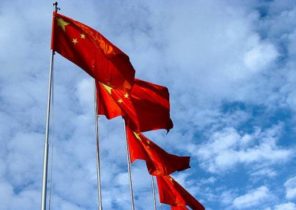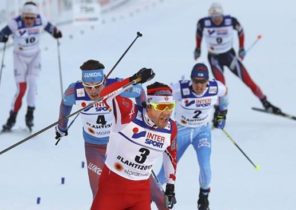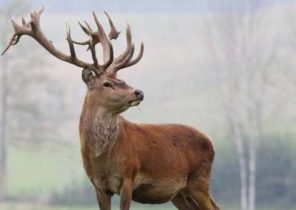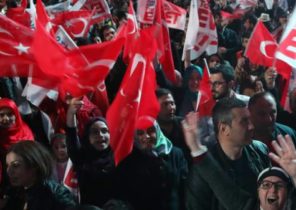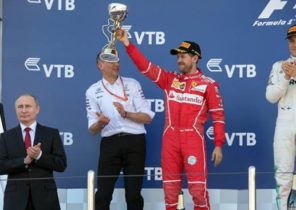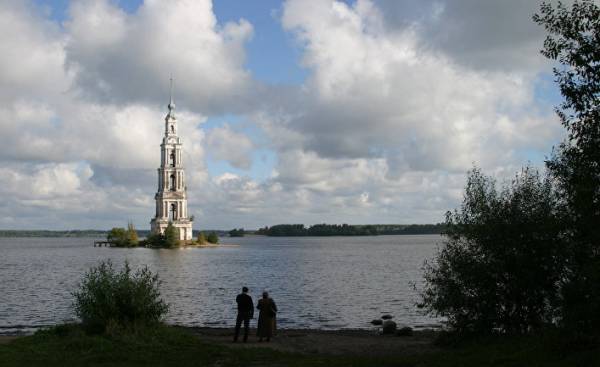
The sun is already low over Moscow North river port, the sailors untie the ship, on Board music, when “Andrei Rublev” begins its journey North. Soon the river becomes wider, the series of Moscow apartment buildings gradually recede. Even the sky is revealed. On the shore are the children and waving, a huge city gradually hidden away. Soon come across only a few fishermen in the coastal bushes. At once becomes quiet. Only the Nightingale singing is heard louder, the farther we sail from Moscow. Around midnight we approached the first gateway. The massive statue of Stalin-era stand against the reddish night sky, when the ship slowly lowered into the lock chamber.
We are on the channel Moscow — Volga, which leads us farther North in the direction of St. Petersburg. There is still four of the next gateway until we reach the Volga. In the morning, early dawn, about three o’clock the sun rises around seven o’clock, the first passengers are already sitting in the bar. The air is clean, the outlines are clearly visible, a magnificent summer houses of Muscovites with brilliant blue and green tile roofs located on the steep banks. Then open the blue expanse of water of the first reservoir, from which Peeps the classic bell tower of Kalyazin, built in the classical style, the latest sign of the drowned city, which was so much on this waterway.
Even Peter the great dreamed of a waterway from Moscow to St. Petersburg, he ordered to dig the first canals. Subsequent kings did the same thing, but to the XX century, the waterway was too narrow and shallow. Ships in the dry summer season on the long runs had to pull up the haulers on the Volga and Sheksna. Only Stalin managed to make a waterway from Moscow to the Baltic and White seas navigable all over. Thousands of prisoners died during the construction of the canal, tens of thousands of people were forced to move.
Today the system of channels connecting the Volga “the five Russian seas”, as reported in the morning internal radio station: Baltic and White sea in the North to the South of the Caspian, Azov and Black seas. In ancient times the Vikings used these waterways. Likewise, incoming and merchants and conquerors, the gang of robbers and kings. The Volga trade route of the German Hanseatic League was connected with the trading routes of the silk road. In the middle of a huge river system lies Moscow, which gradually subdued all the rest of the Principality and in the XV century, was elevated to the capital of this vast Empire. Even from a distance, the gilded domes of churches declare the wealth of kings, both then and today. Fresh shiny gilding the dome in Uglich with green stripes shores. We arrived at the place of our first Parking.
© Paul Semenovodcheskoe verst
Our ship is not the only one that landed here, there’s another river cruise ship, both approximately 300 passengers, but the chaos on the pier was less than expected. After a few minutes of confusion, a group of tourists is distributed between awaiting on the shore the guides and gradually lead them to the churches decorated with medieval frescoes. Who wants to, he can just walk along the shore, admire the domes-cupolas between the white trunks of the birch trees and enjoy stunning silence. The bustle, the dust and noise of Moscow seem to be remaining behind, we departed from the capital of only one hundred kilometers of the aerial flight. But the roads are wide and empty, apartment buildings up to three stories high, and most industrial enterprises, if any were sometime not working.
A rattling bus takes our group to the edge of town in a family who invited us to a homemade vodka with herbs and freshly baked cakes. Sergey, the owner, works on a poultry farm, the sons are studying in the Institute in Yaroslavl, a rich trading town down river. Sergei’s wife Galina unemployed, since then, they have closed the shop where she worked. Now it is engaged in the vegetable garden, feeding chickens and rabbits and accepts guests, if find to them road. In recent years, came only a few Germans, unfortunately, she says, and that in recent years, so many improvements. Monasteries and churches were restored, paved boulevards, everywhere there are souvenir shops, cafes and bars. The Germans are always welcome. The hospitality is so cordial, the food in a small room so plentiful that we take her word for it. During tea with raspberry jam Moscow with her politics seem very far away.
At night we swam to the Rybinsk reservoir. We’re a little cold when standing on the upper deck and watching the endless water surface, for which our ship is sailing all night. The channel is clearly marked, we carefully go around the lake in different directions, not to be stranded at home, an old factory or the Church tower. Stalin had long kept their plans secret, because even he was afraid of resistance. As a result of construction of dams on the Volga and the Sheksna, along with their nearly 60 tributaries was flooded the whole valley with more than 700 villages and towns. More than four thousand hectares of arable land disappeared under the water. Even the climate has changed, the summer months become more wet and more severe, too cold for wheat, which were grown earlier in this fertile lowland. A few years ago, a scientific station for studies of the effects of changes in the environment. The amount of received power was compared with the damage caused by the project is negligible, this leaves no doubt even the transmission of internal radio stations in Russian language.
The next morning we are already on the Sheksna. While the shore is so close that it seems as if to them, you can reach it with your hands. For hours the landscape is almost unchanged, while we sit in the restaurant and eat during concerts in the evenings and then when we with half-closed eyes lying in the cabin, and sails past just the soft curve of the coast.
The farther we advance North, the less likely to get a brick house from the vicinity of Moscow and Yaroslavl, they give place brightly painted wooden houses, which here and there occur on the beach, with wooden quays and rowing boats tied to posts. On this route cities a little, occasionally seen in the distance working village, sometimes sails past a cargo ship. It seems that the channel is completely at the disposal of cruise ships that sail along quietly, between green Islands and covered with birch shores, which sometimes Peeps through the dome-onion Church or monastery. But often we see only the blue of water and sky, greens of the coast and white clouds, the lower edge of which is delineated by the line.
I always imagined cruises boring, and now I can’t break away from this quietly floating Mima landscape. It seems that the other passengers feel the same. On the upper deck were gathered a small group. Heard the guttural voices of Israelis, taciturn Norwegians, the French, all the time playing cards and only from time to time cast a glance at the river, the Belgians and the Russians occupied the sunbeds, Spanish and Portuguese leaders on dance events, the Germans together with the Dutch singing Russian folk songs. Most traveling is middle-aged people have white hair, only the Russian group is much younger, with them children and teenagers. For them, the world may seem self-evident, surprising even their ancestors crossed this country on the rivers. Under the guidance of Marina together make dumplings — Russian tortellini, the sounds of musicians from the ship are learning folk dances. Who wants to, early in the morning on the top deck to do morning exercises and a little yoga, and the need to close my eyes and feel only a slight swaying of the ship. Or just in one of the bars to enjoy endless Northern sunset.
Olga, ship Manager at “Andrei Rublev” is a strong girl, not very tall, with short cropped blond hair, which not only perfectly speak English and Spanish, but also impresses in the role of entertainer. She strictly follows the program of travel and staff vigorously concerned that many nationalities on Board do not interfere with each other, so that as expected left the ship after the tour back in time. In a small office on the lower deck every day going Russian guides. The team is young but professional. Most maintainers from the Russian province of Kazan and Rostov-on-don, and it is not the first summer working on the river cruise ships. Andrew among them — the only man. He Urals and speaks in French, although he — like almost all his colleagues here have never been abroad. Xenia at the registration Desk for the first time on a cruise ship, she is still shy, speaks slowly, trying to speak correctly and wants to someday become a translator. Maria with her dark skin from the South of Russia, it can be taken for a Spaniard when she temperamentally gives salsa lessons. In love with her, without exception, not only Portuguese and Spanish
About the policy of the Board not say. Only Fedor, who is accompanied by his wife, Olga, does not distract ourselves from provocative debates. He was about thirty years old, he is a former tax inspector and has already sold diamonds in Israel and American refrigerators in Rostov-on-don. It is a strange pan-Slavism, wears on his t-shirt ancient Slavic runic characters and working on one environmental organization on the don. He believes that we, the Germans, manipulated by the Americans and Ukrainians. Only in this way, according to him, can explain our unforgivable stupidity, namely, to announce Russia sanctions. If you put aside his bellicose statements, he is peaceful man who prefers vodka instead of drinking herbal tea and meditating in the evenings on the upper deck. Putin has not only on t-shirts and dolls — always head and shoulders above their American or European opponents — his love and the young people on Board. They are proud of their country. Of course, not all perfectly, but where everything is perfect? Sanctions, economic crisis and the accompanying inflation has reduced the incomes of almost a third — but still in stores finally become more Russian products, even Russian tractors began to produce again — and began to buy Chinese buses instead of German, which several years ago have so a reliable ride.
When we reached lake Onega, our captain was finally able to switch to automatic control system and take on the bridge passengers. It represents a sort of fatherly type who all his life spent on cruise ships. “Andrei Rublev” was built in 1981 to the yard in East Germany for the then Soviet Union. For many years he sailed the Dnieper, Ukraine has not yet sold after the pivotal events of its fleet. Since 1998 he floats along the Volga. Since then, the Russian cruise ships can also float and foreign tourists. The ship can withstand waves up to 3.5 meters, however, at 2.5 meters we have to stay in port. Lake Onega lake Ladoga after that we will sail on the following day, the second largest lake in Europe and is known for its storms. Fortunately, the weather is merciful, and in the evening we reach Kizhi, an island on the North, the great lakes and one of the most beautiful goals of our journey. There awaits us, a researcher at the Museum to accompany us during the walk around the island to the famous multi-domed wooden churches. If at the beginning of our journey Russian folk art seemed more colorful kitsch, we now rejoice playing the paint on the iconostasis, which creates a contrast of melancholic beauty of the landscape.
© RIA Novosti, Ilya Timin | go to fotomasterov of intercession of Theotokos on the territory of state historical-architectural and ethnographic Museum-reserve “Kizhi” in Karelia
The last stop before we sail to St. Petersburg with its palaces and castles, it Mandrogi, a village which the Germans burned down during the second world war and which some years ago was restored as the village-Museum of art and craftsmanship. Here bought the last Souvenirs and shore fry kebabs until we reached St. Petersburg, the Northern Venice avenues, castles and gardens. While the men drag our suitcases from the ship, the team is going to discuss the situation, because in the evening on Board will be new guests and will sail this time towards the South.
Fedor said that if you want to feel the real Russia, you need to swim along the Volga towards the South, the Tatars, the Bashkirs and the Cossacks. But what is the “real” Russia? Except she’s not Moloch Moscow, with its datatypename roads and gilded domes or sleepy Golitsyn on White lake? I’ll look for the answer to this question.
